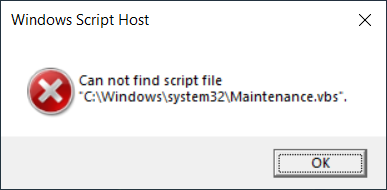Fix: Can not Find Script File Maintenance.vbs
A popup that says “Cannot find script file C:\WINDOWS\system32\Maintenance.vbs” appears every time you start your computer, and you have to close it yourself each time. This error means Windows is trying to run a script file that isn’t there anymore.

It usually happens when a virus or a cleaning tool was removed, but not all of its startup settings or scheduled tasks were deleted. In this article, we will discuss different ways to solve this error.
1. Recreate a *.vbs File
The first step is to recreate a fresh maintenance.vbs file in Windows. After creating it, we will place it in its original location to replace the problematic file. When you restart your computer, the system should run the new file and the error should disappear.
- Create a new text document on your Desktop and type the following:
Wscript.Quit
- Click File > Save As. In the “Save as type” dropdown, choose All Files (*.*).
- Name the file Maintenance.vbs, save it, and close the editor.
- Copy the new file to the following folder:
C:\Windows\System32
- Restart your computer and check if the problem still appears.
2. Perform System File Check
Sometimes, Windows errors happen because system files are corrupt. Microsoft provides a tool called System File Checker (SFC) to help fix these problems. SFC scans for corrupt system files and can repair them automatically.

To run SFC, you need to open Command Prompt with administrator rights. Follow our guide on How to Run SFC Scan in Windows 10 for easy step-by-step instructions. If any bad files are found, SFC will download and replace them automatically.
3. Perform DISM Cleanup
Windows 10 includes a very useful tool called Deployment Image Servicing and Management (DISM). You can use DISM if SFC is unable to fix your files, or if additional help is needed to repair the Windows image.

Run the DISM Repair Tool as an administrator. Let the process finish completely and then restart your computer before trying the next steps.
4. Check for Malware
Another reason you might see this error is if your system has been infected by malware. It’s a good idea to run an antivirus scan to make sure your files are clean.
Most Windows computers come with Windows Defender already running to help catch viruses and malware. Make sure your Windows Defender is turned on before you start the scan.
It’s good practice to scan with more than one antivirus program. You can also use Malwarebytes to search for Malware as an extra security measure.




